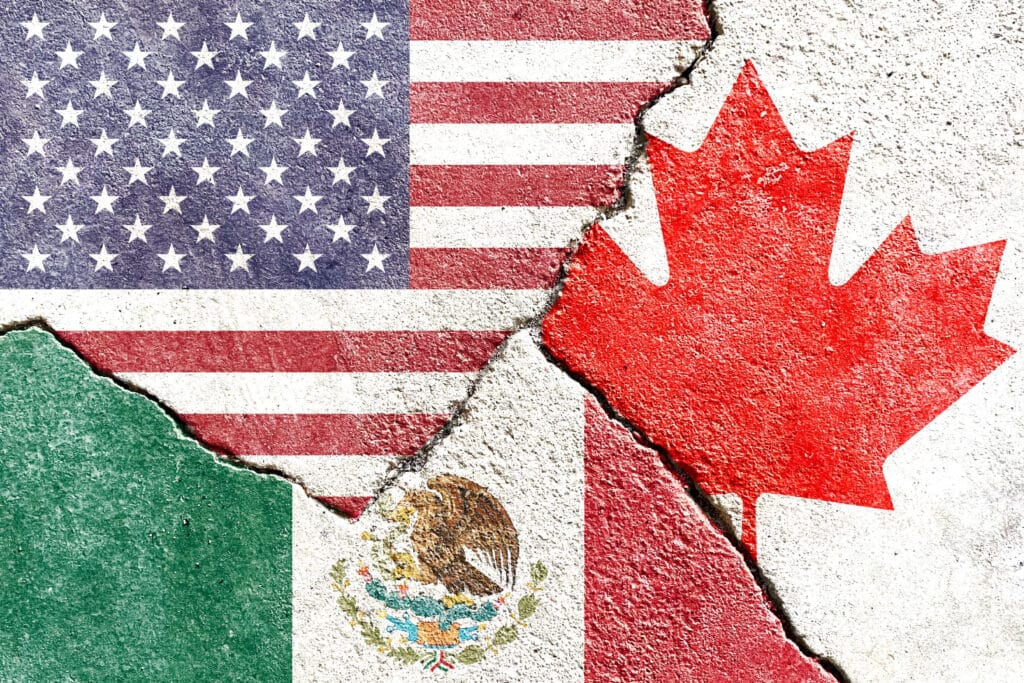It’s been a busy week, and we’re here to break down the major events in the USMCA (United States-Mexico-Canada Agreement) fallout and the potential future implications for the U.S., Canada, and Mexico.
Recap
On February 1, 2025, President Donald Trump announced a 25% tariff on imports from Canada and Mexico, citing national security concerns.
According to a statement from the White House, Trump also intended to implement similar 25% tariffs on imports from Mexico and additional tariffs on imports from China on top of those which are already in place.
In response, Canada unveiled retaliatory tariffs on $155 billion worth of U.S. goods. In a statement, the Department of Finance Canada says the country is moving forward with 25% tariffs on hundreds of billions worth of goods.
Below is a breakdown of the key developments since February 1, their implications, and how this evolving situation could impact the USMCA trade agreement and relations with China and the European Union.
U.S. Tariffs: Rationale and Details

The U.S. tariffs on Canada and Mexico were set to take effect on February 4, 2025 under the International Emergency Economic Powers Act (IEEPA), which allows the president to address national emergencies. The U.S. administration has said the tariffs would be implemented as a response to the cross-border flow of fentanyl and illegal immigration into the United States.
The 25% tariff would apply to most imports from Canada and Mexico, while energy resources from Canada would face a lower 10% tariff.
The U.S. has also imposed an additional 10% tariff on imports from China as part of the same measures.
Along with the aforementioned national security angle, the U.S. administration has emphasized its trade deficit with Canada, particularly in manufacturing, as a contributing factor to the decision.
Canada’s Response: Retaliatory Tariffs
Canada responded with a two-phase plan to impose 25% tariffs on $155 billion worth of U.S. goods.
Phase 1: Tariffs on $30 billion worth of U.S. goods, including orange juice, peanut butter, wine, spirits, beer, coffee, appliances, apparel, footwear, motorcycles, cosmetics, and pulp and paper would have taken effect on February 4, 2025.
Phase 2: Tariffs on an additional $125 billion worth of goods, including passenger vehicles, steel and aluminum products, aerospace goods, beef, pork, dairy, and recreational vehicles, would be subject to a 21-day public comment period before implementation.
Canada has also established a remission process to provide relief for businesses and workers affected by the tariffs. The Government of Canada has reiterated that all options, including non-tariff measures, remain on the table if the U.S. continues its current course. In addition, several Canadian provinces and territories announced their own internal retaliations against the U.S., including taking American products off of shelves at government liquor stores and changing government procurement policies to exclude American companies.
Impact on Mexico

Mexico, like Canada, is directly affected by the U.S. tariffs. The Mexican government vowed to retaliate but did not announce specific retaliatory measures. The tariffs could disrupt supply chains across North America, particularly in the automotive, agriculture, and energy sectors, where the three countries are deeply interconnected under the USMCA.
Mexico is a key exporter of automotive parts, agricultural products, and electronics to the U.S., and tariffs could significantly impact these industries.
The situation adds to existing tensions between the U.S. and Mexico over immigration and drug trafficking, further complicating bilateral relations.
Will the EU get involved?
On February 3rd, 2025, U.S. President Donald Trump, upon arriving in Maryland from Florida, told the BBC that tariffs on European Union (EU) goods imported into the U.S. could happen “pretty soon.”
He criticized the EU for its trade imbalance with the U.S., particularly in car exports, and warned that tariffs might be imposed as a result.
The EU responded by promising retaliatory measures if tariffs are introduced. European carmakers’ stock values fell in response to the potential tariffs.
30-Day Reprieve
The announcement of a pause in tariffs for Mexico and Canada on February 3, 2025 has provided temporary relief for businesses on both sides of the border. Mexico committed to deploying National Guard officers to curb drug trafficking and migration, while Canada agreed to send forces to its southern border to fight these issues.
The tariffs on Mexico and Canada were delayed for 30 days as both countries worked on addressing U.S. concerns, while the 10% tariff on China took effect as scheduled.
Looking Ahead

As President Trump’s trade policies continue to shape the future of North American trade, the urgent need to rework the USMCA is becoming increasingly clear.
Ongoing issues such as U.S. dairy access to Canada, Mexico’s stance on GMO corn, and tariff threats related to fentanyl smuggling complicate the prospect of simply extending the agreement.
With these disputes in play, experts predict that by 2026 the USMCA may face significant renegotiation or even replacement to address these concerns.
The recent delay in tariff impositions between the U.S. and Canada on February 3 underscores the fluidity of the situation, with both countries seeking to protect their economic interests while trying to maintain stable trade relations.
However, the uncertainty surrounding tariffs continues to make it difficult for small business owners to plan effectively, as noted by the CFIB, creating challenges for long-term decision-making and operational stability.
Ultimately, we predict that the future of North American trade boils down to the fate of the USMCA. As negotiations continue and priorities shift, the agreement’s potential reworking or replacement will be crucial in resolving these ongoing issues.
Achieving a balanced and effective deal will be key to ensuring stability for businesses across the continent while navigating the complexities of the trade landscape.



